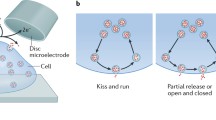Abstract
The fusion of vesicles and exocytosis release of neurotransmitters into the extracellular space for detection and chemical signal decoding by neighboring cells is the key process in neuronal communication. It is important to understand what regulates exocytosis because the amount of neurotransmitters released into the synaptic cleft has a direct impact on brain function such as cognition learning and memory as well as on brain malfunctions. Much success in molecular biology can be credited for the existence of simplified model systems. Therefore, for gaining deeper insights into the details of exocytosis and what controls vesicle-mediated neurotransmission, functional artificial cells for exocytosis have been developed that can be used for studying various biophysical aspects and roles of molecules affecting exocytosis, which is difficult to study in living cells. Here, we describe the design and fabrication of specific artificial cell models and how chemical measurements at these cells can be implemented for probing dynamics of the exocytosis fusion pore and its effect on the regulation of neurochemical release. We introduce bottom-up synthetic methods for constructing model cells using protein-free giant unilamellar vesicles (GUV) as starting material, which allows further tuning of molecular complexity in a manner that is not possible in living cells and therefore can be used for dissecting the role of essential molecular components affecting the exocytosis process. The experimental setup uses microscopy video recording, micromanipulation and microelectroinjection techniques, and amperometry detection to study neurotransmitter release from these cells mimicking exocytosis.
Access this chapter
Tax calculation will be finalised at checkout
Purchases are for personal use only
Similar content being viewed by others
References
Vance JA, Devaraj NK (2021) Membrane mimetic chemistry in artificial cells. J Am Chem Soc 143:8223–8231
Salehi-Reyhani A, Ces O, Elani Y (2017) Artificial cell mimics as simplified models for the study of cell biology. Exp Biol Med 242:1309–1317
Xu C, Hu S, Chen X (2016) Artificial cells: from basic science to applications. Mater Today 19:516–532
Cans AS, Wittenberg N, Eves D et al (2003) Amperometric detection of exocytosis in an artificial synapse. Anal Chem 75:4168–4175
Cans AS, Wittenberg N, Karlsson R et al (2003) Artificial cells: unique insights into exocytosis using liposomes and lipid nanotubes. Proc Natl Acad Sci 100:400–404
Keighron JD, Wigström Kurczy ME et al (2015) Amperometric detection of single vesicle acetylcholine release events from an artificial cell. ACS Chem Neurosci 6:181–188
Mellander LJ, Kurczy ME, Najafinobar N et al (2014) Two modes of exocytosis in an artificial cell. Sci Rep 4:3847
Najafinobar N, Mellander LJ, Kurczy ME et al (2016) Cholesterol alters the dynamics of release in protein independent cell models for exocytosis. Sci Rep 6:33702
Simonsson L, Kurczy ME, Trouillon R et al (2012) A functioning artificial secretory cell. Sci Rep 2:824
Jesorka A, Stepanyants N, Zhang H et al (2011) Generation of phospholipid vesicle-nanotube networks and transport of molecules therein. Nat Protoc 6:791–805
Criado M, Keeller BU (1987) A membrane fusion strategy for single-channel recordings of membranes usually non-accessible to patch-clamp pipette electrodes. FEBS Lett 224:172–176
Karlsson A, Karlsson R, Karlsson M et al (2001) Networks of nanotubes and containers. Nature 409:150–152
Karlsson M, Sott K, Davidsson M et al (2002) Formation of geometrically complex lipid nanotube-vesicle networks of higher-order topologies. Proc Natl Acad Sci 99:11573–11578
Stengel G, Zahn R, Höök F (2007) DNA-induced programmable fusion of phospholipid vesicles. J Am Chem Soc 129:9584–9585
Bath BD, Michael DJ, Trafton BJ et al (2000) Subsecond adsorption and desorption of dopamine at carbon-fiber microelectrodes. Anal Chem 72:5994–6002
Karlsson M, Nolkranz K, Davidsson MJ et al (2000) Electroinjection of colloid particles and biopolymers into single unilamellar liposomes and cells for bioanalytical applications. Anal Chem 72:5857–5862
Mosharov EV, Sulzer D (2005) Analysis of exocytotic events recorded by amperometry. Nat Methods 2:651–658
Author information
Authors and Affiliations
Corresponding author
Editor information
Editors and Affiliations
Rights and permissions
Copyright information
© 2023 The Author(s), under exclusive license to Springer Science+Business Media, LLC, part of Springer Nature
About this protocol
Cite this protocol
Wang, Y., Cans, AS. (2023). Artificial Cells for Dissecting Exocytosis. In: Borges, R. (eds) Chromaffin Cells. Methods in Molecular Biology, vol 2565. Humana, New York, NY. https://doi.org/10.1007/978-1-0716-2671-9_18
Download citation
DOI: https://doi.org/10.1007/978-1-0716-2671-9_18
Published:
Publisher Name: Humana, New York, NY
Print ISBN: 978-1-0716-2670-2
Online ISBN: 978-1-0716-2671-9
eBook Packages: Springer Protocols




